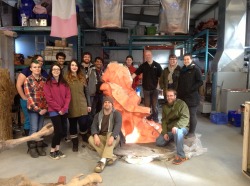Being Vikings: Experiential Learning at Memorial University

Experiential learning is a key element of teaching which I have only recently began to embrace as an essential element to learning. During last autumn’s survey course of Viking-Age archaeology, I arranged three workshops for my students to illustrate various craft and fighting techniques in the Viking Age, to understand the craft makers and the warriors as well as the tangible evidence of Viking-Age activities. I felt I needed to mix things up, to get people out of the classroom, and excite them about their subject. As we could not visit Trelleborg, or Birka, or York, imagination and enthusiasm were necessary for success.
A local spinner, weaver and felter demonstrated spinning techniques to the class. We all gave our best effort to spin some single-ply yarn, some with good results. While we span, two students presented their critiques of various articles about dress, adornment and textile production, providing discussion points for the others. We discussed the virtues of felted cloth over woven cloth. The class estimated that felted cloth was more robust, more waterproof and durable, yet taking far less time to produce, and therefore cheaper, than woven cloth. One would assume that felted cloth would been more desirable for those living and especially working in the Viking Age, where time is of a premium. Yet woven cloth is more likely to be found from the grave. The discussion took shape around status, type of grave goods, actual and extant. By handling the finished yarns and textiles, and examining various types of reproduced clothing, the students better understood how status was made manifest through textile production, as well as through study of dress accessories and jewellery which are more easily accessible in the cultural record. Underscored through the discussion was the importance of textile production for the whole of society, and not solely “women’s work”.
A visit to the working Newfoundland Bronze Foundry led my students to understand various processes of jewellery production, including sand casting and the lost wax technique. Sculptor Morgan MacDonald was generous of his time and scheduled a bronze pour of the famous Bowring Park caribou antlers to coincide with our visit. His views on the problems of production, including time involved, gave the students a deeper understanding of the importance of “things” and the creation of such things in the pre-industrial world.
Students also enjoyed a demonstration of Viking-Age battle techniques by an active re-creator from the Sea Wolves group in St. John’s. What was meant to be a fun and light-hearted demonstration was also very informative, as students learned about methods of waging war, the logistics of littoral and riverine warfare, the psychology of the warrior, and what would drive someone to become a berserkr. We also concluded with a serious discussion about the spirituality of warfare, and attachment to equipment, such as the sword and axe.
It is difficult to bring the ‘real world’ to the classroom when studying the past to practically apply knowledge and test assumptions. I was delighted by the local response to assist in learning about the Viking Age, and my students benefitted from the experiences. My recommendation is to seek out local enthusiasts. Not only will students benefit, but it is also a great way to engage the community.